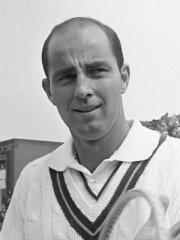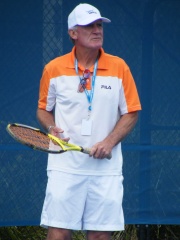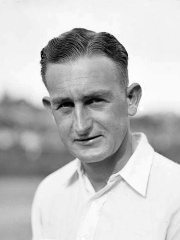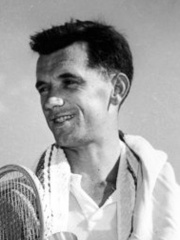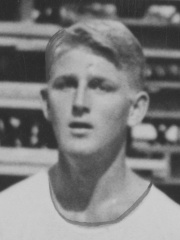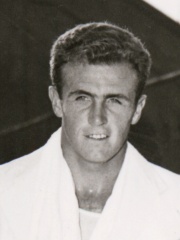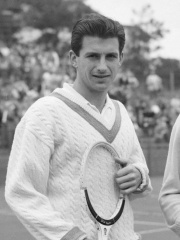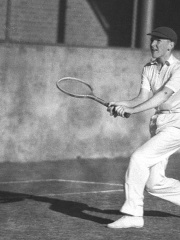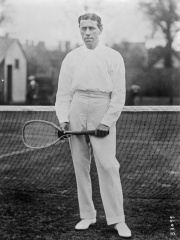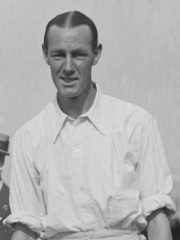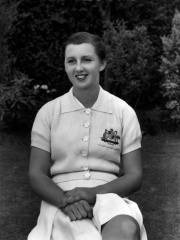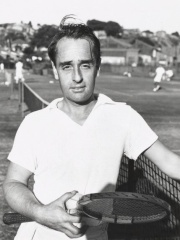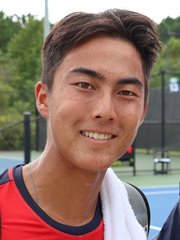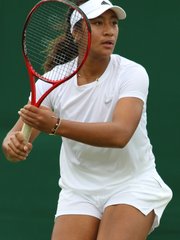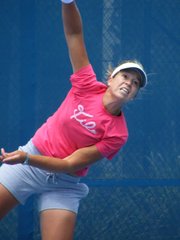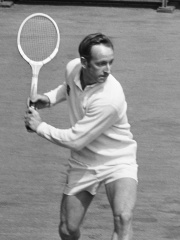
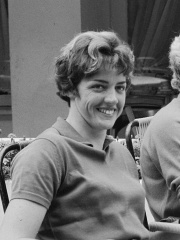
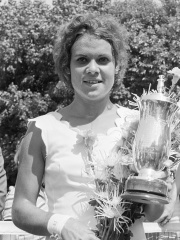
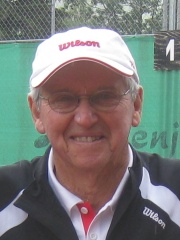
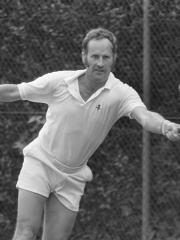
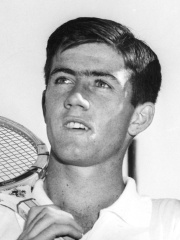
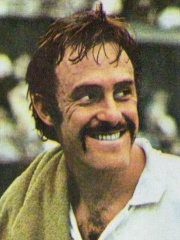
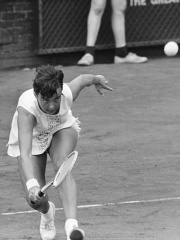
The Most Famous
TENNIS PLAYERS from Australia
This page contains a list of the greatest Australian Tennis Players. The pantheon dataset contains 1,569 Tennis Players, 120 of which were born in Australia. This makes Australia the birth place of the 2nd most number of Tennis Players.
Top 10
The following people are considered by Pantheon to be the top 10 most legendary Australian Tennis Players of all time. This list of famous Australian Tennis Players is sorted by HPI (Historical Popularity Index), a metric that aggregates information on a biography's online popularity. Visit the rankings page to view the entire list of Australian Tennis Players.

1. Rod Laver (b. 1938)
With an HPI of 71.59, Rod Laver is the most famous Australian Tennis Player. His biography has been translated into 56 different languages on wikipedia.
Rodney George Laver (born 9 August 1938) is an Australian former professional tennis player. Laver was ranked as the world number 1 professional player indisputably for five years from 1965 to 1969, and by some sources also in 1964 and 1970. He was also ranked as the number 1 amateur in 1961 and 1962. Laver won 200 singles titles across his amateur and professional careers, the most won by any tennis player. Laver won 11 Grand Slam tournament singles titles and 8 Pro major titles. He completed the Grand Slam (winning all four majors in a calendar year) in singles twice, in 1962 and 1969; the latter remains the only time a man has done so in the Open Era. He also completed the Pro Slam (winning all three pro majors in one year) in 1967. Laver won titles on all court surfaces of his time (grass, clay, hard, carpet, wood), and he contributed to five Davis Cup titles for Australia during a time when the Davis Cup was deemed as significant as the four majors. The Rod Laver Arena (the main show court of the Australian Open) and the Laver Cup tournament are named after him.

2. Margaret Court (b. 1942)
With an HPI of 70.53, Margaret Court is the 2nd most famous Australian Tennis Player. Her biography has been translated into 57 different languages.
Margaret Court (née Smith; born 16 July 1942), also known as Margaret Smith Court, is an Australian former world number 1 tennis player and a Christian minister. Her 24 women's singles major titles and total of 64 major titles (including 19 major women's doubles and 21 major mixed doubles titles) are the most in tennis history. Court was born in Albury, New South Wales. In 1960, aged 17, she won the first of seven consecutive Australian Open singles titles. She completed the career Grand Slam in singles aged 21 with her victory at Wimbledon in 1963. Taking a brief hiatus in 1966 and 1967, Court played as an amateur until the advent of the Open Era in 1968. She completed the Grand Slam by winning all four major singles titles in 1970, part of a record six consecutive major singles victories. Court gave birth to her first child in 1972, but returned to tennis later in the year and won three major singles titles in 1973. She took similar breaks after her second and third children were born, retiring from the game in 1977. Court is one of only three players in history (all women) to have won the "Boxed Set", consisting of every major title (the singles, doubles and mixed doubles). She is the only player in tennis history to complete a double Boxed Set. Court is also one of only six tennis players to win a double career Grand Slam in two disciplines, matching Roy Emerson, Martina Navratilova, Frank Sedgman, Doris Hart, and Serena Williams. She also won the Fed Cup with Australia on four occasions. The International Tennis Hall of Fame states "For sheer strength of performance and accomplishment there has never been a tennis player to match (her)." Evonne Goolagong called her the greatest female tennis player of all time. Having grown up Catholic, Court became associated with Pentecostalism in the 1970s and became a Christian minister in that tradition in 1991. She later founded Margaret Court Ministries.

3. Evonne Goolagong Cawley (b. 1951)
With an HPI of 69.92, Evonne Goolagong Cawley is the 3rd most famous Australian Tennis Player. Her biography has been translated into 46 different languages.
Evonne Fay Goolagong Cawley (née Goolagong; born 31 July 1951) is an Australian former professional tennis player. She was ranked as the world No. 1 in women's singles by the Women's Tennis Association (WTA), and was one of the world's leading players in the 1970s and early 1980s. Goolagong won 86 WTA Tour-level singles titles, including seven singles majors, and 46 doubles titles, including seven doubles majors. At the age of 19, Goolagong won the French Open singles and the Australian Open doubles championships (the latter with Margaret Court). She won the women's singles tournament at Wimbledon in 1971, becoming the 2nd woman in the Open Era to complete the Channel Slam (winning the French Open and Wimbledon in the same year). Goolagong is the only woman to beat Court, Martina Navratilova, and Chris Evert in a grand slam final. In 1980 she won Wimbledon again, this time as a mother and becoming the first mother to win the title in 66 years. She represented Australia in three Fed Cup competitions, winning the title in 1971, 1973 and 1974, and was Fed Cup captain for three consecutive years. After retiring from professional tennis in 1983, Goolagong played in senior invitational competitions, endorsed a variety of products, worked as a touring professional, and held sports-related leadership roles. Goolagong was named Australian of the Year in 1971. She was appointed as a Member of the Order of the British Empire in 1972 and as an Officer of the Order of Australia in 1982. Goolagong was inducted into the Sport Australia Hall of Fame in 1985, the International Tennis Hall of Fame in 1988, and the Aboriginal Sporting Hall of Fame in 1989. She leads the Goolagong National Development Camp for Indigenous boys and girls, which encourages Indigenous youth to stay in school.

4. Roy Emerson (b. 1936)
With an HPI of 65.86, Roy Emerson is the 4th most famous Australian Tennis Player. His biography has been translated into 39 different languages.
Roy Stanley Emerson (born 3 November 1936) is an Australian former tennis player who won 12 Grand Slam singles titles and 16 Grand Slam doubles titles, for a total of 28 Grand Slam titles. All of his singles Grand Slam victories and 14 of his Grand Slam doubles victories were achieved before the open era began in 1968. He is the only male player to have completed a career Grand Slam (winning titles at all four Grand Slam events) in both singles and doubles, and the first of four male players to complete a double career Grand Slam in singles (later followed by Rod Laver, Novak Djokovic, and Rafael Nadal). His 28 major titles are the all-time record for a male player. He was ranked world No. 1 amateur in 1961 by Ned Potter, 1964 by Potter, Lance Tingay and an Ulrich Kaiser panel of 14 experts and 1965 by Tingay, Joseph McCauley, Sport za Rubezhom and an Ulrich Kaiser panel of 16 experts. Emerson was the first male player to win 12 singles majors. He held that record for 30 years until it was passed by Pete Sampras in 2000. He also held the record of six Australian Open men's singles titles until 2019 when Novak Djokovic won his seventh title. Emerson won five of those titles consecutively (1963–67), a still-standing record. Emerson is one of only five tennis players ever to win multiple slam sets in two disciplines. Emerson was a member of a record eight Davis Cup–winning teams between 1959 and 1967. Unlike several of his contemporaries, he chose to remain an amateur player and did not turn professional before the advent of the Open Era.

5. Fred Stolle (1938 - 2025)
With an HPI of 64.53, Fred Stolle is the 5th most famous Australian Tennis Player. His biography has been translated into 30 different languages.
Frederick Sydney Stolle, AO (8 October 1938 – 5 March 2025) was an Australian amateur world No. 1 tennis player and commentator. He was born in Hornsby, New South Wales, Australia. He was the father of former Australian Davis Cup player Sandon Stolle.

6. Neale Fraser (1933 - 2024)
With an HPI of 64.46, Neale Fraser is the 6th most famous Australian Tennis Player. His biography has been translated into 29 different languages.
Neale Andrew Fraser, (3 October 1933 – 2 December 2024) was an Australian champion tennis player. Fraser is the most recent man to have completed the triple crown (i.e. having won the singles, doubles, and mixed doubles titles at a Grand Slam tournament), which he did in 1959 and 1960 at the U.S. National Championships (now known as the US Open). He won the 1960 Wimbledon championships. Fraser was ranked world No. 1 amateur tennis player in 1959 and 1960 by Lance Tingay and Ned Potter. After his playing days were over, he was the non-playing captain of Australia's Davis Cup team for a record 24 years.

7. Ken Rosewall (b. 1934)
With an HPI of 64.01, Ken Rosewall is the 7th most famous Australian Tennis Player. His biography has been translated into 39 different languages.
Kenneth Robert Rosewall (born 2 November 1934) is an Australian former world No. 1 professional tennis player. Rosewall won 147 singles titles, including 23 majors: a record 15 Pro Majors and eight Grand Slam tournaments. He also won 15 Pro Majors in doubles and nine Grand Slam doubles titles. Rosewall achieved a Pro Slam in singles in 1963 by winning the three Pro Majors in one year, and completed the career Grand Slam in doubles. Rosewall had a renowned backhand and enjoyed a long career at the highest levels from the early 1950s to the early 1970s. He was ranked as the world No. 1 men's tennis player by multiple sources from 1961 to 1964, multiple sources in 1970, and Rino Tommasi in 1971 and 1972. Rosewall was first ranked in the top 20 in 1952, and last ranked in the top 20 in 1977. Rosewall is the only player to have simultaneously held Pro Slam titles on three different surfaces (1962–63). At the 1971 Australian Open, he became the first man in the Open Era to win a Grand Slam tournament without dropping a set. Rosewall won world professional championship tours in 1963, 1964, and the WCT titles in 1971 and 1972. A natural left-hander, Rosewall was taught by his father to play right-handed. He developed a powerful, effective backhand, but his serve was merely accurate and relatively soft. He was 1.70 m (5 ft 7 in) tall, weighed 67 kg (148 lb), and sarcastically was nicknamed "Muscles" by his fellow-players because of his lack of them; however, he was fast, agile, and tireless, with a deadly volley. A father of two and grandfather of five, Rosewall lives in northern Sydney.

8. John Newcombe (b. 1944)
With an HPI of 63.91, John Newcombe is the 8th most famous Australian Tennis Player. His biography has been translated into 41 different languages.
John David Newcombe AO OBE (born 23 May 1944) is an Australian former professional tennis player. He was ranked as the world No. 1 in both men's singles and men's doubles. Newcombe won a combined 26 major titles: seven in singles, a former record 17 in men's doubles, and two in mixed doubles. He also contributed to five Davis Cup titles for Australia during an age when the Davis Cup was deemed as significant as the majors. Tennis magazine rated him the 10th best male player of the period 1965–2005.

9. Kerry Melville (b. 1947)
With an HPI of 63.87, Kerry Melville is the 9th most famous Australian Tennis Player. Her biography has been translated into 28 different languages.
Kerry Melville Reid (née Melville; born 7 August 1947) is an Australian former professional tennis player. During her 17-year career, Reid won a major singles title and 26 other singles titles, and was the runner-up in 40 singles tournaments. Reid was included in the year-end world top-ten rankings for 12 consecutive years (1968–1979). She won at least one tournament annually from 1966 through 1979, except for 1975. Her career-high ranking was world No. 5 in 1971, behind Margaret Court, Billie Jean King, Evonne Goolagong, and Rosie Casals.
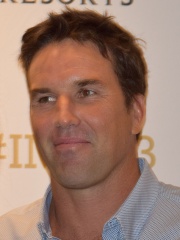
10. Pat Rafter (b. 1972)
With an HPI of 62.31, Pat Rafter is the 10th most famous Australian Tennis Player. His biography has been translated into 47 different languages.
Patrick Michael Rafter (born 28 December 1972) is an Australian former professional tennis player. He was ranked as the world No. 1 in men's singles by the Association of Tennis Professionals (ATP) for one week in 1999, and world No. 6 in doubles. Rafter won eleven ATP Tour-level singles titles, including two majors at the 1997 and 1998 US Opens, as well as two Masters titles. He was also the runner-up at Wimbledon in 2000 and 2001. In doubles, Rafter won ten titles, including a major at the 1999 Australian Open partnering Jonas Björkman, and two Masters titles. Rafter became the first man in the Open Era to win the Canada Masters, Cincinnati Masters and the US Open in the same year, a feat repeated only by Andy Roddick in 2003, and Rafael Nadal in 2013. Rafter is the third man in the Open Era to reach at least the semifinals of every major in both singles and doubles, after Rod Laver and Stefan Edberg, and remains the last man to date to accomplish this. He is also been considered to be a sex symbol in the media.
People
Pantheon has 120 people classified as Australian tennis players born between 1867 and 2002. Of these 120, 85 (70.83%) of them are still alive today. The most famous living Australian tennis players include Rod Laver, Margaret Court, and Evonne Goolagong Cawley. The most famous deceased Australian tennis players include Fred Stolle, Neale Fraser, and Jack Crawford. As of April 2024, 10 new Australian tennis players have been added to Pantheon including Peter Doohan, Laurie Warder, and Anne Minter.
Living Australian Tennis Players
Go to all RankingsRod Laver
1938 - Present
HPI: 71.59
Margaret Court
1942 - Present
HPI: 70.53
Evonne Goolagong Cawley
1951 - Present
HPI: 69.92
Roy Emerson
1936 - Present
HPI: 65.86
Ken Rosewall
1934 - Present
HPI: 64.01
John Newcombe
1944 - Present
HPI: 63.91
Kerry Melville
1947 - Present
HPI: 63.87
Pat Rafter
1972 - Present
HPI: 62.31
Judy Tegart-Dalton
1937 - Present
HPI: 60.37
Bob Hewitt
1940 - Present
HPI: 60.03
Chris O'Neil
1956 - Present
HPI: 59.14
Tony Roche
1945 - Present
HPI: 58.43
Deceased Australian Tennis Players
Go to all RankingsFred Stolle
1938 - 2025
HPI: 64.53
Neale Fraser
1933 - 2024
HPI: 64.46
Jack Crawford
1908 - 1991
HPI: 60.88
Mervyn Rose
1930 - 2017
HPI: 59.42
Lew Hoad
1934 - 1994
HPI: 59.01
Ken McGregor
1929 - 2007
HPI: 58.32
Ashley Cooper
1936 - 2020
HPI: 58.19
John Bromwich
1918 - 1999
HPI: 58.13
Norman Brookes
1877 - 1968
HPI: 57.85
James Anderson
1894 - 1973
HPI: 57.24
Nancye Wynne Bolton
1916 - 2001
HPI: 56.93
Adrian Quist
1913 - 1991
HPI: 56.89
Newly Added Australian Tennis Players (2025)
Go to all RankingsPeter Doohan
1961 - 2017
HPI: 49.50
Laurie Warder
1962 - Present
HPI: 45.26
Anne Minter
1963 - Present
HPI: 41.60
Andrew Kratzmann
1971 - Present
HPI: 37.51
Todd Perry
1976 - Present
HPI: 36.49
Rinky Hijikata
2001 - Present
HPI: 35.54
Olivia Gadecki
2002 - Present
HPI: 32.65
Nathan Healey
1980 - Present
HPI: 32.26
Destanee Aiava
2000 - Present
HPI: 31.23
Sophie Ferguson
1986 - Present
HPI: 27.73
Overlapping Lives
Which Tennis Players were alive at the same time? This visualization shows the lifespans of the 25 most globally memorable Tennis Players since 1700.


